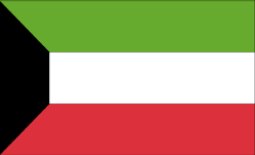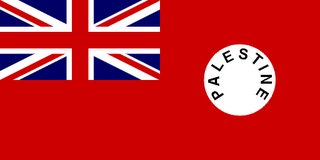The Flag of Palestine
We are all familiar with the flag of the Palestinian movement, but how many of us would recognise the only official flag of Palestine?

the flag of the Palestinian movement
Since the late 1960's, when the quest for an independent Palestinian state became a focal point of the Arab/Israeli conflict, the red, green, white and black of the Palestinian flag has been synominous with the cause.
Variants of the flag are common to many Arab nations and this is no coincidence.

the flag of Jordan

the flag of Sudan

the flag of Kuwait
The colours are traditional and derive from the Pan-Arab nationalist movement which swept the Middle East in the 50's and 60's, on waves stirred by Egypt's Gamal Nasser.
It was a powerful influence that saw many countries replace their traditional flags with designs incorporating his tricolor.
Nasser's imperial dream was called the United Arab Republic.
It started with an alliance between Egypt and Syria in 1958.

The flag of the U.A.R.
The two stars represented Egypt and Syria, and borrowing an idea from the American flag, they would have increased in number had more Arab states joined the union.
As it was, the U.A.R. project only lasted a couple of years and was politically dead when Syria promtly opted out.
After the divorce, Egypt kept the name "United Arab Republic" for a few years, and strangely Syria kept the U.A.R. flag as its own (complete with the two stars!!!)
The U.A.R. may be dead, but its colours live on as potent symbol of a collective aspiration.....the revival of the glorious epoque of Arab regional hegemony.
These imperialist ambitions motivated the failed military attempts to destroy Israel, but also underpinned the subsequent invention of Palestinian nation identity.
Nasser's legacy lives on in the flag of the Palestinian movement, but what of the "only official flag of Palestine" mentioned earlier?
It's question which actually raises central issues which will also be explored on this site.
The problem in finding anything to do with the former country of Palestine is that it has never actually been a nation state.
Since the Roman coined the name, Palaestina, it has simply been a loosely defined region, under the control of a continuous succession foriegn empires.
To its later Arab population, the region was often simply known as "Southern Syria". They identified themselves as Syrians late into the 20th Century.
The word "Palestine" was only really used by the West - a secular alternative to the more common label "The Holy Land".
Of course, its not uncommon for regions to have internationally recognised names - but try and find the national flags of the America's Mid-West, England's Lake District or Scandanavia!!!!
The scope of the region became more defined and the use of the word "Palestine" was formalised when the British Empire assumed control from the defeated Ottoman Empire in the 1920's.
Around this time, Palestine did get a flag - a British Empire ensign:

the only official flag of Palestine
Perhaps one day, someone will take it to wave at a Palestinian protest march.
That should provoke some interesting questions.
Related links:
Historical Flags of Palestine
Pre-Nasser Arabic flags
